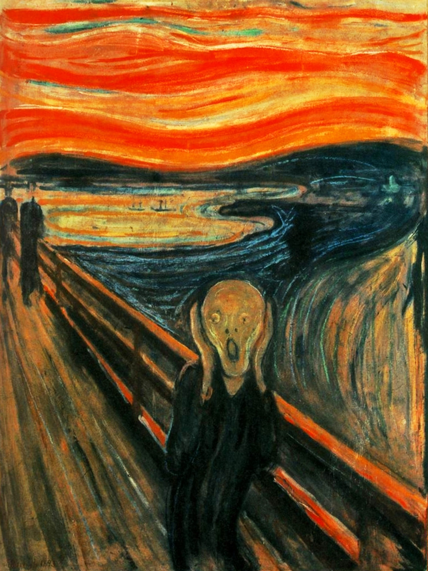News blog - artistravel international
Edvard Munch's Painting "The Scream"
Edvard Munch's The Scream
The sky beats threatening fiery waves, including a blue-green, seemingly untouched landscape. A bridge inevitably leads out of the safe landscape to the horizon, where the glowing sky strikes. The pedestrians on the bridge seem to suspect nothing except for the sexless figure in the foreground: the body writhes, the overlapping hands hit the ears, the eyes of the skull-like face are scarred, the mouth wide open - it escapes a shrill scream.
Moment - a scream? From a painting? A scream caused by colors? The paradox of visually capturing an acoustic event succeeds the Norwegian painter Edvard Munch at the turn of the century. With "The Scream" he creates a key image of art history, a milestone for Expressionism, for whose development the image is so important.
Edvard Munch describes his own life from the beginning gloomy. On December 12, 1863, he was born as a second child in the strictly religious family Munch. Illness, madness, and death kept watch over his cradle like black angels. Contrary to expectations, little Edvard survived. In the next five years, his mother gave birth to three more siblings. After that she died, completely weakened by tuberculosis. The farewell to the mother Munch was traumatic in memory.
His aunt took over the education of the children, after the death of his favorite sister and she managed to give Edvard and his siblings hope and to promote their creativity. At the age of seventeen, Munch wrote in his diary: "My decision now is to become a painter." This was followed by training at the Academy of Fine Arts and many - made possible by scholarships - travel to the metropolises of Europe.
In his diary, he began to capture his "emotional experiences," which he later turned into images. His recurring melancholy moods increased the color intensity of his impressions, as he described. Thematically he focused on the big questions of life: love and death. The partly scandalous success of his exhibitions, especially in Berlin, pleased him. But travel and heavy drinking consumed his nerves. Privately he retired, in a quarrel with his lover, a gunshot wound on the hand. He had hallucinations, felt persecuted. Munch was on the verge of a psychosis.
In this nervously strained time falls the pastel painted copy "The Scream" from 1895, which is also based on a sensually intense experience, as Munch notes: "I walked down the street with two friends - when the sun went down - the sky suddenly turned blood red - I stopped, leaned tired against the railing - over the blue-black fjord and the city lay blood and tongues of fire - my friends went on, and I, trembling with fear, stood there - and I felt that an endless scream went through nature.“
It is this feeling of human existential anxiety that Munch kept preoccupying himself with and made him make different versions of "The Scream" in different techniques. In all these pictures he shows himself as an amorphous, almost fetus-like curved figure who nevertheless has a skull as a face - especially in the later version of 1910. The transient fate of human existence, the connection between birth and death, is united in this figure. The viewer is also affected by this inevitable fate, as the bridge at the lower edge of the picture opens to the entire width and pulls the viewer through the pull of perspective together with the screaming figure, together with the unsuspecting pedestrians into the depth of the picture. There, at the end of the bridge, a sky coloured like the end of the world awaits them.
Munch's painterly realization of his emotional world changed the history of art. He reflected his soul in the environment. The motif of the outer landscape was for him only the means to express his own soul landscape. In this way he helped Expressionism, the art of expression, on its feet. The expressive intensity of the scream motif, however, was not to be regained in any of his paintings.
Posted in Painting on Nov 30, 2018


